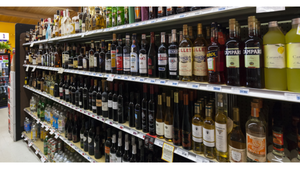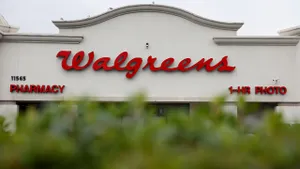THE NEW WORLD OF INDEPENDENTS 1998-05-04 (4)
GRAND RAPIDS, Mich. -- "We're really too little to be big and we're definitely too big to be little."With that thought, Jeff Gietzen, president and chief executive officer of D&W Food Centers here, raises perhaps the major dynamic facing his highly praised, 24-unit supermarket company. The 55-year-old-company finds itself in that growing middle tier of supermarket operators who are bigger than traditional
May 4, 1998
DAVID ORGEL
GRAND RAPIDS, Mich. -- "We're really too little to be big and we're definitely too big to be little."
With that thought, Jeff Gietzen, president and chief executive officer of D&W Food Centers here, raises perhaps the major dynamic facing his highly praised, 24-unit supermarket company. The 55-year-old-company finds itself in that growing middle tier of supermarket operators who are bigger than traditional mom-and-pop retailers but smaller than the Goliath chains crowding the doorsteps of independent supermarkets.
D&W -- like many in this growing middle tier of entrepreneurial, family-owned firms -- still counts itself among the ranks of independents, even though its store base has increased. D&W's goal is to add to its sales base -- through unit expansion and other means -- before the accelerating wave of consolidation crashes in.
"A big part of our strategy has been to build a good infrastructure: people, systems, processes," Gietzen said in an interview with SN here. This D&W executive's credentials include the current chairmanship of the Independent Operator Committee of the Food Marketing Institute. "I do not want a weak foundation. With a strong foundation I think we can grow. We have to grow.
"Well, we've been building infrastructure. Now we'd like to start knocking on some doors, in terms of an acquisition. I can knock, but you have to have someone there who is willing to answer. So we're not always on the control side of an acquisition. But we're trying to say, who is out there, and how can we work to make a bigger system."
D&W does a lot of things well. In many respects it is a model for independents in the late 1990s. The western Michigan operator, whose sales were about $400 million last year, is a leader in fresh-foods merchandising, customer service and progressive human resources practices for its 4,300 associates. The company continues to expand its business despite competition from locally based Meijer Inc. and a growing cluster of retailers offering food in its marketing area.
But much of D&W's strength -- as with any visionary independent -- comes from its willingness to assess its future and ask questions, even the toughest questions. Gietzen believes in strategizing about potential scenarios that could spell disaster for D&W or any independent operator.
"Let's create a doomsday scenario that I think actually is going to be real life," Gietzen began. "Let's say Wal-Mart decides to drop supercenters into western Michigan, which up to this point they haven't. They are in Michigan now, but without supercenters. At some point they're going to run out of room and decide to drop in supercenters.
"We understand pretty well what Meijer's response will be here. Things will get very competitive. Prices will get very competitive. If prices get to the point of being irrational, I don't care who our best customers are, if we're not competitive, customers are not going to pay more than they feel is fair. So we have to take costs out now to stay competitive."
D&W's ability to ask the toughest questions includes methodically assessing its full range of future growth options. "In the back of my mind there is that question: what does the competition and consolidation question mean to D&W?" Gietzen said. "And what different set of questions should we be asking ourselves in terms of how we grow? Do we partner with somebody to grow? Does that mean a financial partner? Does that mean merger vs. acquisition? I'm only asking those questions right now because I think I have an obligation to ask. Being uninformed or ignorant is not good leadership. To say that because I'm asking it implies we're going to do it isn't true."
What is D&W's battle plan for building its business in a fast-changing industry?
Making further strides with its strongest suits -- customer intimacy and fresh-foods merchandising -- while battling to hold and win market share in key center-store categories.
Growing the sales base through attempts at faster unit expansion, potential acquisitions and identification of other growth opportunities, such as the current Michigan franchising arrangement with Manhattan Bagel Corp, Eatontown, N.J.
Pulling more costs from the operation through improved distribution and systems advances following recent major strides in those areas.
Holding to a distinct company culture that places a very high value on customers, associates and community.
D&W was a very small operator in its first two decades. Begun in 1943 as an IGA, the company was run by Roy Woodrick and a partner. In the early 1960s, Roy's son Bob took the reins and the D&W name and logo were adopted, a move that heralded a period of fast growth. D&W's 24 units, no longer affiliated with IGA, are supplied by wholesaler Spartan Stores, which is locally based. D&W is still owned by the Woodrick family, which includes, among others, Bob and his wife, Alecia; Bob's son Rob; daughter Georgia (D&W's internal food and style consultant); and Gietzen, who is Georgia's husband. A couple of executive committee members also have some ownership.
A 22-year veteran of the company, the energetic Gietzen, who is 41 years old, has held a succession of key roles. He began with store-level duties, helped lead the company into the scanning age, directed operations and added sales and marketing to his portfolio. He became chief operating officer in 1990 and CEO in 1994.
D&W's regional mark is most noticeable in the fresh-foods arena. To ensure that success, D&W self-supplies a wide range of perishables, including meat, seafood, deli and floral. "In other words, all points-of-difference areas," Gietzen said. Wholesaler Spartan supplies dry grocery, dairy, frozens and general merchandise and health and beauty care.
D&W's fresh-foods formula involves maintaining control over production. An elaborate central kitchen operation, which will soon need to be rebuilt for larger capacity needs, continually flows ingredients, side dishes and a growing menu of ready-to-heat meal items into the stores. A meat-processing facility is bringing more meat categories into the case-ready realm and adding to the ranks of value-added meat products with the assurance of centrally managed consistency.
Sparked by the success of its new format in Holland, Mich., D&W continues to grow in the meal-solutions arena. The new format groups a wide range of meal options -- ready to cook, ready to heat and ready to eat -- in one area called Market Square. Chefs are on hand to demonstrate preparation techniques. A growing roster of chilled, prepacked items includes entrees and side dishes. A hot bread kiosk featuring hard crusted breads and rolls helps enhance the effect. A cafe with some seating enables customers to grab a sandwich or panini lunch.
D&W's advertisements neatly spell out the meal choices for shoppers, categorized by preparation time. In one recent flier headlined "What's Cooking," the ready-to-heat option was a barbecue meal pack that serves four. The headlined ready-to-eat meal was an eight-piece fried chicken dinner. Under the ready-to-cook banner, D&W spotlighted Old Bay Whitefish, listing cooking directions and ingredients needed to complete the meal. The Chef's Kitchen demonstration areas, now in five stores, enable shoppers to view meal preparation and buy the components so they can do it themselves. A recent choice was Raspberries Mariner, which called for ingredients including a pint of fresh raspberries and 2 ounces of Grand Marnier liquer.
D&W's new look emulates the feeling of a "market or streetscape," with elements including track lighting and chalk boards. Many elements of the new format will be rolled out to the rest of the stores as they are expanded and remodeled.
How has D&W managed to create a big fresh-foods hit regionally and attract visitors from around the country? Here again, D&W's talents for self-critical assessments appear to regularly refine its performance. Gietzen is candid about D&W's regional standing in fresh foods and remaining improvements he'd like to see. "We pretty much own deli/food service from a food-retail perspective," Gietzen said. "But although we do a good job in produce, we must do a better job. Meijer has a strong position there. We can do better in sourcing, variety, quality.
"And bakery is the department that I'm still trying to drive the hardest from a destination point of view. For example, we want to improve sweets and torts. In town everyone is average in bakery. We need to own bakery."
D&W also embraces customer feedback: it conducts regular customer surveys and has an 800 phone number that draws about 1,000 calls a month.
Also fueling D&W's fresh-foods efforts is its arrangement with Manhattan Bagel. Last spring D&W acquired exclusive franchising rights to develop Manhattan Bagel shops in 11 Michigan counties. It agreed to open at least 20 Manhattan Bagel units over a three-year period, including in-store and freestanding units. D&W also acquired the rights to open up to 10 Manhattan Bagel branded, self-service display units or limited-service kiosks inside supermarkets or convenience stores in the 11-county area.
"It's an effort to increase sales base profitability and continue to learn more about food service," Gietzen said. "We didn't have a great bagel, and we didn't want to reinvent it, since it takes as much time to build as to buy."
D&W's first effort was an in-store, full-service, open production Manhattan Bagel shop inside a D&W store in Grand Haven, Mich. That store, in turn, supplies bagel needs for a few other stores, reinforcing D&W's preference for centralized production.
The Holland, Mich., store incorporates a Manhattan Bagel kiosk. In January D&W opened its first freestanding Manhattan Bagel unit in Cascade, Mich. -- a 2,400-square-foot store -- which immediately began supplying some D&W supermarkets with bagels and other products.
Late last year Manhattan Bagel filed for reorganization under Chapter 11 of the Federal Bankruptcy Act, but D&W said that move is not expected to affect its business arrangement. Indeed, D&W wouldn't mind finding more opportunities like this one.
"Would we do more things like this? Possibly, if it's within our geographic operating range of west and southwest Michigan. If the right opportunity came along and it fit into our strategy from the standpoints of central kitchen or food service, then I would consider another Manhattan Bagel-type opportunity."
D&W has tied its future to fresh foods, but it is by no means retreating in other categories. Among nonfresh specialty efforts, an extensive wine area becomes a destination department in some stores, as does an expansive international foods grocery aisle.
"In center store, some categories will be destination and others commodity-based," Gietzen said. "We have to understand what we can do to minimize the [center-store market-share] loss."
That loss, which affects the whole supermarket industry, is driven by the plethora of retailers getting into grocery merchandising. And many of these operators are staking their claims in western Michigan.
"We're starting to get Kmart pantries. Walgreen and Rite Aid have aggressive store expansions. We have Boston Market and KFC and Aldi. There's more square footage growth than population growth.
"Operators like Target, Kmart and Rite Aid are as much food operators as anyone else now when it comes to center-store products," Gietzen stressed.
D&W is fine-tuning its category management approach as a prime weapon. While the effort was initially slow in gelling, Gietzen sees a more rapid category management rollout for the company. "Now we're having vendors work as category leaders."
D&W also recognizes the need to battle the expansion of its competitors by getting bigger itself. Square-footage expansion is a priority, and larger-sized stores are highly valued.
"Today, if you don't have a relatively new unit in a market, and people around you have newer units, then customers will go where they feel the energy, the excitement of the merchandising. Your store doesn't have to even be that old, but if you're in an area with, let's say, three competitors, a Meijer, another independent or an Aldi or a Target, and your store is the oldest unit, even just three or four years old, that's definitely going to hurt your sales."
So the goal is to create bigger stores, and 1998 is a busy year for that effort. The company is pursuing four store remodels; two expansion/remodels; one new replacement store; and one new store, in Portage, Mich.
"We're really trying to complete improvements to current stores faster than the pace of a year or two ago," Gietzen said.
D&W isn't looking to expand beyond its current market region, but if it does, it would do so through acquisitions rather than new construction, Gietzen said. "Whether we would put the D&W name on it depends on how strong that independent is," he said.
While D&W is committed to quickening its expansion pace, it also recognizes the limits of its options. "In the last 10 years or so, we've added on average a store and a half a year. So what we're doing now represents a similar pattern, accelerated because of the increased pace of competition and the need to make sure units are up to speed. I think what is increasing is the need for D&W to somehow create that larger system, bigger sales base. The tactic can be the same -- new stores from the ground up and acquisitions -- but we can speed the pace of that. But we're not always in control of acquisitions: you need a willing seller and buyer. We're not looking to buy problems."
Perhaps D&W has more control over another device to improve its business: cost-cutting and improving efficiencies. D&W has worked for a couple of years with Senn-Delaney Group, a unit of Arthur Andersen, Chicago, to reduce back-room inventories, decrease out-of-stocks, improve distribution practices and make progress in related areas. Now D&W hopes to build on those initiatives.
"We created better methods for receiving and sorting so the work is now done in the back room rather than on the selling floor," Gietzen said. "We now get a wide variety of categories on one truck, which means fewer deliveries and more efficiencies.
"We moved to same-day ordering to improve efficiencies. Also, we took all 24 stores into electronic DSD receiving in many categories, so we had electronic check-ins to the stores."
Gietzen will also increasingly look to his wholesaler to help D&W manage its costs better. "On the subject of reducing costs, we need Spartan to assist us in that arena," he said. "We need them to take costs out of their system and grow their system to grow the business. We need Spartan to be driving a bigger base of business for themselves, however they do that -- whether that means serving other retailers that they don't serve today, or by some other means."
D&W is particularly proud of its credo of "establishing customer intimacy." The company likes to publicize its "11th Commandment," which reads, "At D&W it is impossible to do too much for a customer." So it's not surprising that a frequent-shopper card program is a perfect match for D&W's culture.
D&W's Value Card Program, unveiled in 1996, has drawn excellent shopper response and is being fine-tuned and enhanced along the way, Gietzen explained. A major goal has been to add to the usefulness of the card for customers.
"We must make sure we continue to add value to the card, other than just getting discounts in the store," he said.
"We've gone very aggressively into card-partner programs so that other organizations will honor the D&W Values Card and provide either discounted products or services. Examples are hardware stores, beauty shops, car washes, sporting goods stores, white-linen restaurants, in some cases.
"We'd like to tie vendors into the card more than we have done. We know our redemptions are much higher than coupons, so that's of high interest to manufacturers."
In one store, shoppers who get store rebates based on their purchase levels can direct those monies to be donated to the school of their choice.
The next steps are to add more capacity to the database and to upgrade the front-end point-of-sale system to offer deals at the register.
"We're only limited by the questions we ask, but we're using the card to benefit customers: we can see what they're buying and introduce them to new products."
In a fast-changing industry, one thing about D&W that won't be altered is its commitment to its community, Gietzen insists. D&W's level of support has stood out in an industry that is known for supportive community action. The Michigan retailer's programs touch on many aspects of regional life, from schools to food-relief agencies to diversity enhancement. Gietzen said the driving force behind these efforts is Bob Woodrick, "whose respect for people is our point of difference. It's the right thing to do and it's good for business."
About the Author
You May Also Like




